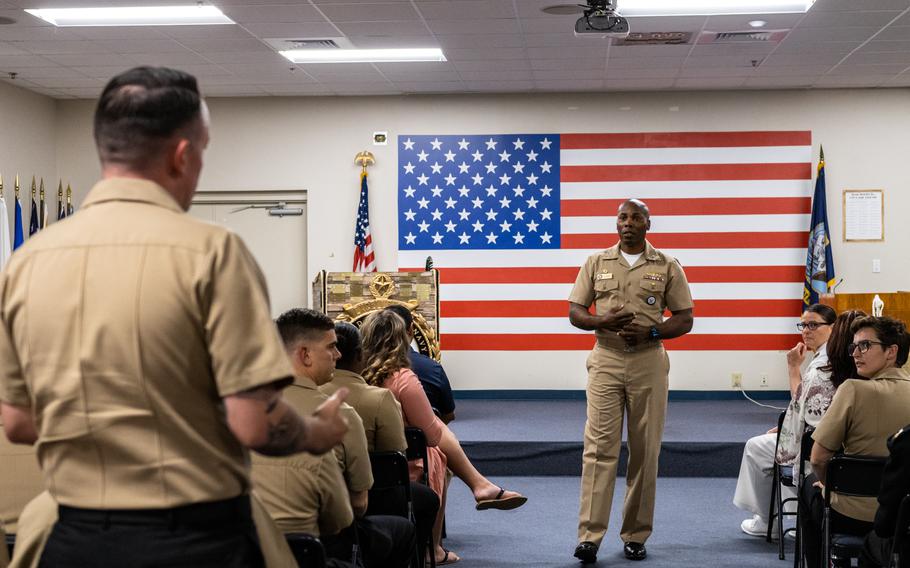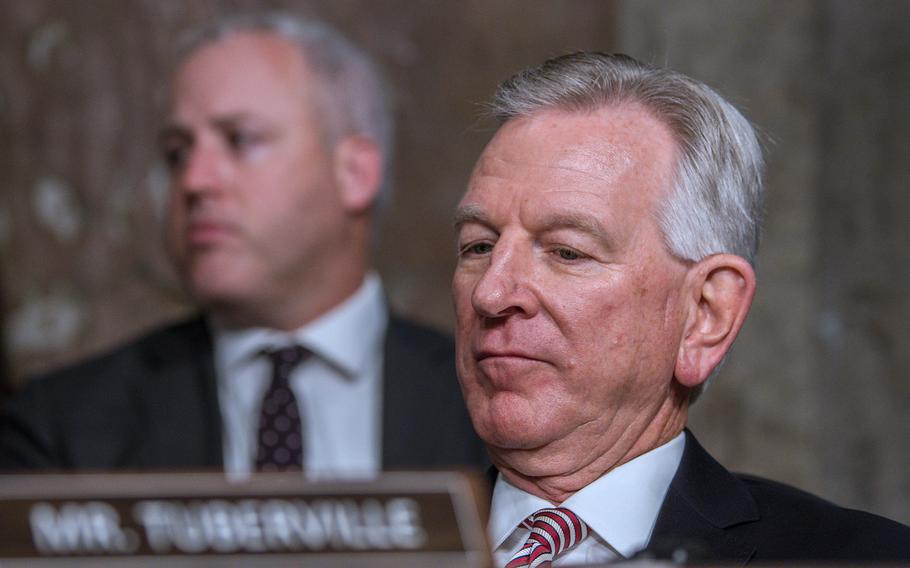
Rear Adm. Alexis Walker, who leads Navy Recruiting Command, takes questions at an event in June in Pensacola, Fla. Walker told senators on Wednesday, Dec. 6, 2023, that educating the public about the Navy is part of the service’s recruiting challenge. (Nava Kiss/U.S. Navy)
WASHINGTON – Leading members of the Senate Armed Services Committee said Wednesday that senators should not leave for the holiday break next week until all military nominations stalled in the upper chamber are confirmed.
The senators challenged their colleagues during a hearing of the committee’s subpanel on personnel after Sen. Tommy Tuberville, R-Ala., blocked hundreds of nominations for 10 months to protest a Pentagon policy that reimburses troops who travel to receive reproductive care, such as abortions. The policy was put in place after many Republican states passed laws heavily restricting or banning the procedure.
Tuberville on Tuesday finally agreed to lift his hold on about 425 promotions for officers of three-star rank or lower. His blockade continues, however, for about a dozen four-star generals.
“It was a grave mistake for one senator to hold our military promotion system hostage over his personal disagreement with the Department of Defense policy,” said Sen. Elizabeth Warren, D-Mass., the personnel subcommittee chairwoman. “We need our commanders in the Pacific to deter China and our service vice chiefs.”
“The Senate should not go home for the holidays until we confirm the remaining nominees,” she added.
Sen. Rick Scott, R-Fla., who has been supportive of Tuberville and his 10-month blockade, agreed.
“It’s resolved except for the four-stars, and I hope what will happen is we’ll go through this process quickly,” he said. “Some people have some concerns, so let’s go through them, let’s do cloture, let’s get a vote on it as we get this done as quickly as possible and I agree with [Warren]. If we can get it done before we go off on the holidays, we should.”
The House and Senate are scheduled for a break that will start Dec. 15 and not return until January.

Sen. Tommy Tuberville, R-Ala., attends a Senate Armed Services Committee hearing on July 12, 2023, on Capitol Hill in Washington, D.C. (Carlos Bongioanni/Stars and Stripes)
The hearing on Wednesday was held to examine the ongoing recruiting challenges for the service branches. For 2023, only the Marine Corps and Space Force met their small recruiting goals. The Army, Navy and Air Force, which sought to sign far more recruits, all failed to meet their targets for the year. The Air Force hoped to sign almost 27,000 active-duty recruits but came up about 2,700 short, Brig. Gen. Christopher Amrhein, commander of Air Force Recruiting Service, said a few weeks ago. The Army hoped for 65,000 recruits and missed by about 10,000, while the Navy aimed for almost 38,000 new active-duty sailors and missed by about 7,500.
“If we were assigning grades, those two services got an A. The Air Force earned a B+, the Army got a B- and the Navy a C+,” Warren said. “For years now, the military has failed to connect with young people who we need to keep this country safe.”
Recruiting commanders at the hearing told the committee that there are various challenges in recruiting troops, including a disconnect between the military and younger Americans and modern challenges such as social media and effects from the coronavirus pandemic. The officers said they also face service-specific challenges.
“Educating the public about what our Navy does, both in conflict and in peacetime, would be helpful,” said Rear Adm. Alexis Walker, who leads Navy Recruiting Command.
“Not everybody is fit to be a Marine,” added Maj. Gen. William Bowers, who leads Marine Corps Recruiting Command. “We are not for everybody. We are looking for a select few young men and women of character who are attracted to the ethos and core values of being part of something bigger than themselves.”
Maj. Gen. Johnny Davis, who leads Army Recruiting Command, said his service offers so many different mission specialties that it can sometimes be overwhelming for potential recruits, which is something the Air Force is also seeing. Amrhein said some young recruits think every Air Force job involves flying planes.
“We also have medical professionals, civil engineers, doctors, maintainers to be able to generate airpower. Making sure everyone understands there are 200 Air Force specialty codes, jobs, is a key component and, I think, a very big challenge,” he said.
The Navy has said its recruiting target for 2024 is about 43,000 active-duty sailors. The Air Force wants to recruit more than 26,000. The goals for the Army and Marine Corps have not yet been announced, but the Army has already said its new target will be lower than last year’s.